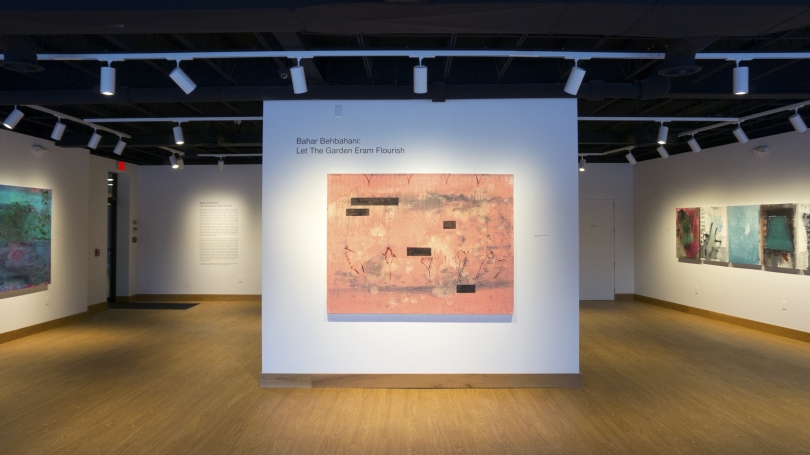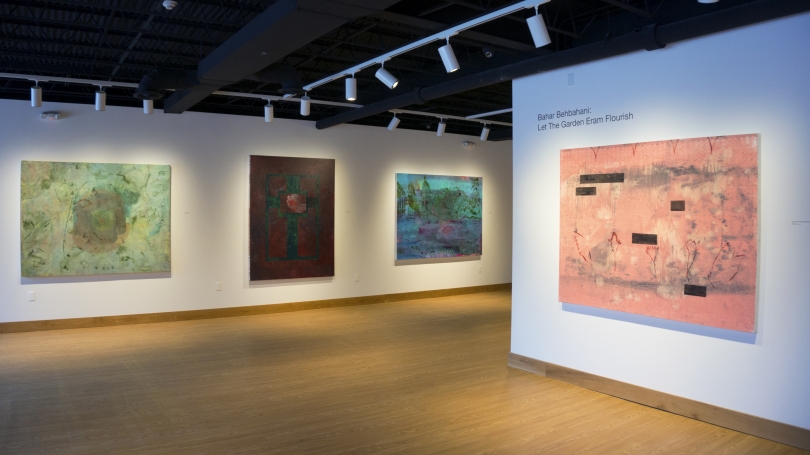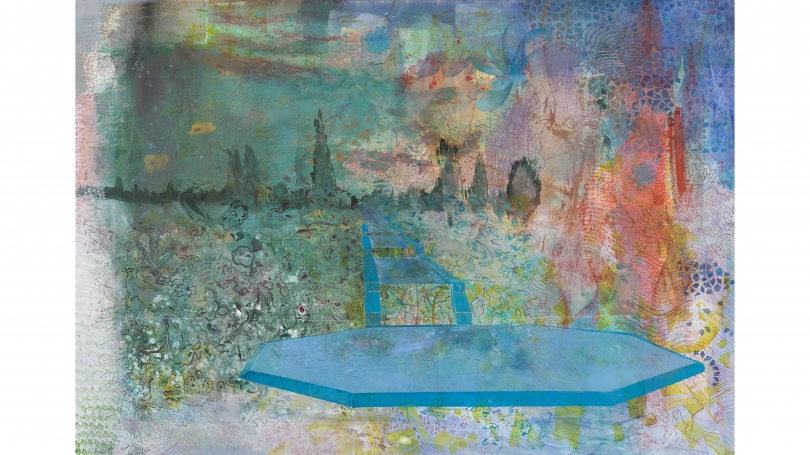Ugochukwu-Smooth C. Nzewi, Curator of African Art
Hood Quarterly, winter 2017
In late 2013, Bahar Behbahani began a series of paintings inspired by her contemplation of the question of identity. She first came to the United States from Iran in 2003. For a while, she moved between Tehran and the United States before relocating permanently to New York in 2007. As a significant leitmotif of Iranian cultural experience, Persian gardens represented a logical recourse for Behbahani in trying to address her sense of being away from home. The suite of paintings, installations, and video in this exhibition, part of her ongoing Persian Gardens series, captures her engagement with what she describes as the psychogeography of place and memory.
The exhibition’s title is taken from a nineteenth-century poem by Ali Khan, poet laureate of the court of Fath Ali Shah, who wrote under the pseudonym Saba, in celebration of garden Eram, one of the oldest in Iran and presently a UNESCO world heritage site. The garden’s rich history is a mirror of old Persia and modern Iranian histories. Its many pavilions and buildings, built over several dynasties by powerful families who once had the garden under their control, are a statement of power and prestige over the ages.
An engineering tour de force, the Persian or Iranian garden has gripped human imagination since its emergence in the sixth century BCE. These walled gardens comprise multilateral structures, connecting aqueducts, networks of water channels, and surrounding trees and vegetation that remain lush all year in the middle of the desert. As objects of beauty, they have attracted people from different walks of life throughout the ages, from the Persian rulers who created them to evoke their personal transcendence and political power to the diplomats, common folk, scholars, and soldiers who have sought out their exotic enchantment.
Haunted by the spirits of fierce power play, Persian gardens are marked by tragedy, love, betrayal, death, and redemption, and mirror Iran’s fraught histories, past and present.
In the Persian Gardens series, Behbahani does not pursue a utopian fantasy or affirm the orientalism that the Western eye seeks in the gardens. Instead, her intensely layered vocabulary, which draws upon the schematic architectural plans, ritual geometry, and ornate aes- thetics of Persian gardens, as well as the poetry they evoke, describes the histories that attend the gardens. We are invited to absorb Behbahani’s rich and complex narratives woven on canvas. She approaches the Persian garden as a metaphor of politics and poetics and seeks the intersection of the public and private there. Highly gestural, Behbahani’s work can be placed within the tradition of mark making and abstraction. Abstraction is her way of seeing, of being, and of grappling with existential questions without necessarily seeking to resolve them. It affords her other possibilities as well: to reflect on self-doubts, personal struggles, expatriation, and the ambiguous space she occupies without the risk of being vulnerable. Her paintings, then, should not be seen strictly through the lenses of eastern, Persian, or Iranian aesthetic traditions. Hybridization, mirage, structures, memory, fantasy, and the power of imagination are some of the things that come to mind when looking at them. Her studio process is laborious. She works on several paintings at the same time. They are all multi-layered and evoke the process of building construction. She begins with preparatory studies, trying out ideas and the ideal vocabulary on study canvases. When she is comfortable with the compositions, she transfers to the intended surface. In several of the works, we encounter bold and tentative markings interspersed with broad strokes and swooshes of bright and cool colors, and concealing thick black lines that populate the picture surface of some of them. Behbahani employs garden layouts and plans to underline the weight of her ideas. In Chronicle of the Garden and Char Bagh (with its quadrilateral design), for example, there is careful consideration of the structure of the garden, mathematical calculations and engineering of the irrigation and planting system, and orientation of water-ways and pools. Behbahani creates architectural nets, covering the middle in the foreground in Char Bagh and Preliminary Steps, drawing inspiration from a type of Dahlia flower called the Persian monarch. In some of the paintings, she features the eight-sided star, a repeating motif that for her describes the power of structure.
Behbahani chooses her colors carefully to convey specific notions or intentions. For example, blue is used in the paint- ings to recall its old-Persian symbolism of royalty, and to represent the ubiqui- tous tile formation in Persian architec- ture. Blue also evokes the abundance of water in Persian gardens. The shades of red used in The Decisions Are Made: Activity Begins, Char Bagh, and some of the canvases of the eight-in-one Chronicle of the Garden refer to the blossoming flowers in Persian gardens. These various elements taken from Persian architectural sites, plans, and scholarly texts, as well as from the building constructions going on around Behbahani’s studio in lower Manhattan, are transformed into abstract forms. Behbahani aspires to contextualize rather than be didac- tic. Like others who have painted famous gardens, including Monet, Van Gogh, Cezanne, and Kandinsky, she is fascinated by both their concep- tual and visual offerings.
Born in Tehran in 1973, Behbahani pursues a multidisciplinary practice that includes paintings, video, instal- lation, and performance. Her work has been featured in major venues, biennials, and film festivals including Queens Museum, New York, Michi- gan State University’s Eli and Edythe Broad Art Museum, Macro, Museum of Contemporary Art, Italy, Asia Art Biennial, Bangladesh, Shanghai Bien- nale, and the Tribeca Film Festival, New York. She was awarded the Open Society Institute’s Art and Culture Network Program grant and a Pollock Krasner Foundation grant (through the Art Omi International Artists Residency) in 2011 and 2013, respec- tively. Her work is in many public and private collections, including the Queensland Museum, Australia, Sharjah Art Foundation, United Arab Emirates, and Columbia Hospital, New York. Behbahani obtained her BFA (1995) and MFA (1998) from the University of Tehran’s School of Fine Arts at a time when the principal form of expression for many Iranian artists was abstraction. This arose out of the necessity to speak with subterfuge due to the political dynamic at play in the country then (which has since improved). The last few years have seen a growing interest in Iranian art in Iran and in the international mainstream, and Let the Garden Eram Flourish is also a metaphor for this recent development in the art world.




